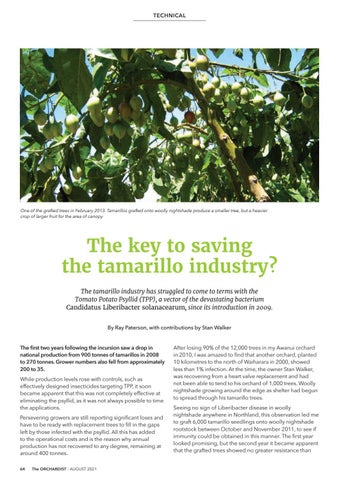TECHNICAL
One of the grafted trees in February 2013. Tamarillos grafted onto woolly nightshade produce a smaller tree, but a heavier crop of larger fruit for the area of canopy
The key to saving the tamarillo industry? The tamarillo industry has struggled to come to terms with the Tomato Potato Psyllid (TPP), a vector of the devastating bacterium Candidatus Liberibacter solanacearum, since its introduction in 2009. By Ray Paterson, with contributions by Stan Walker The first two years following the incursion saw a drop in national production from 900 tonnes of tamarillos in 2008 to 270 tonnes. Grower numbers also fell from approximately 200 to 35. While production levels rose with controls, such as effectively designed insecticides targeting TPP, it soon became apparent that this was not completely effective at eliminating the psyllid, as it was not always possible to time the applications. Persevering growers are still reporting significant loses and have to be ready with replacement trees to fill in the gaps left by those infected with the psyllid. All this has added to the operational costs and is the reason why annual production has not recovered to any degree, remaining at around 400 tonnes. 64
The ORCHARDIST : AUGUST 2021
After losing 90% of the 12,000 trees in my Awanui orchard in 2010, I was amazed to find that another orchard, planted 10 kilometres to the north of Waiharara in 2000, showed less than 1% infection. At the time, the owner Stan Walker, was recovering from a heart valve replacement and had not been able to tend to his orchard of 1,000 trees. Woolly nightshade growing around the edge as shelter had begun to spread through his tamarillo trees. Seeing no sign of Liberibacter disease in woolly nightshade anywhere in Northland, this observation led me to graft 6,000 tamarillo seedlings onto woolly nightshade rootstock between October and November 2011, to see if immunity could be obtained in this manner. The first year looked promising, but the second year it became apparent that the grafted trees showed no greater resistance than





























